9 Tips for Safe Foot Care in African Diabetics
By Chinonso Cynthia Ukah. BNSc, RN, RM, RPHN. Freelance Health Writer. Medically reviewed by A. Odutola, M.B.B.S., PhD, FRCSEd.
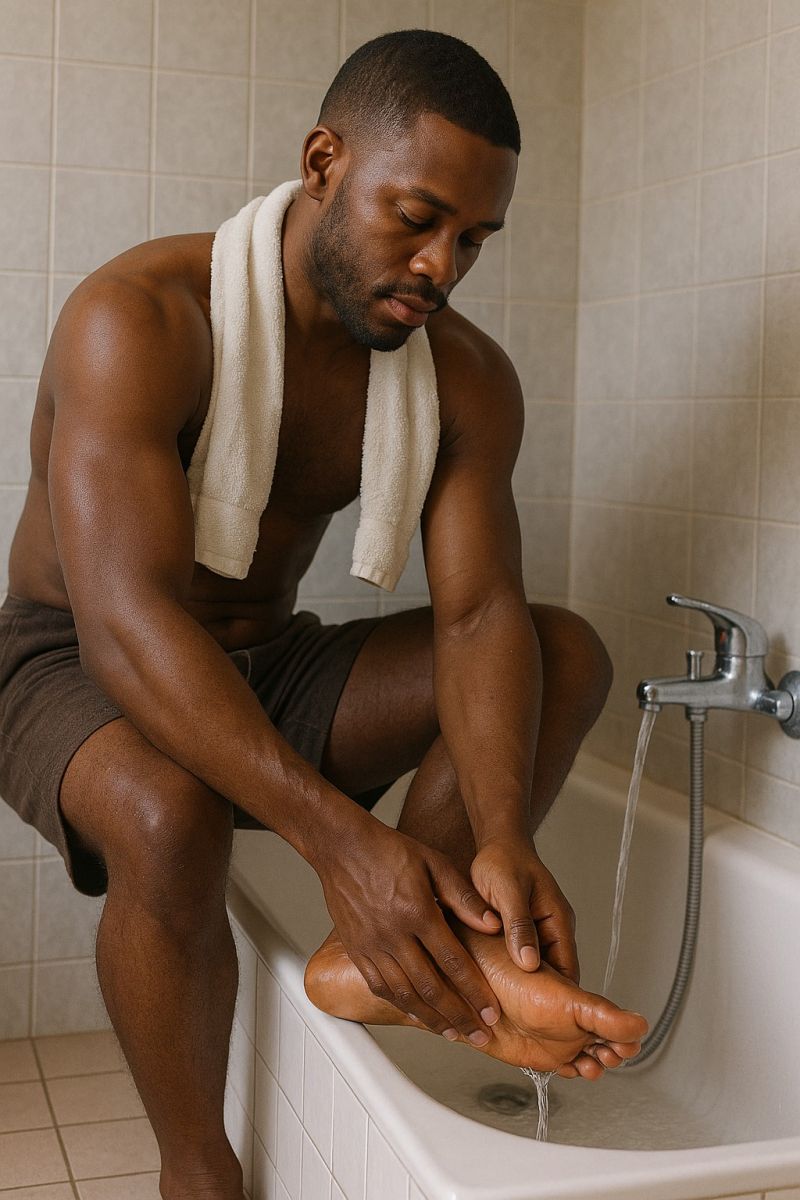
A bare chested African man seating on a tub with a white towel around his neck, washing and inspecting his feet under running water. Credit: AI generated from ChatGpt.
A major challenge for people living with diabetes in Africa is limb amputation and an alarming number of these cases are reported yearly, many of which could have been prevented.
Foot care, which refers to the daily practice of inspecting, cleaning, protecting, and managing the feet, is estimated to reduce the risk of amputation by up to 85%. This practice helps to detect early changes to the feet in order to prevent injury or infection (when a foot ulcer develops).
With many diabetes cases in Africa going undiagnosed, foot care should not be a concern only for those already diagnosed with diabetes. Both diabetics and non-diabetics need to understand and adopt this practice early because foot-related complications are better prevented than treated.
There are two major medical causes of diabetic foot disorders.
1. Diabetic Peripheral Neuropathy (DPN)
This is one of the main reasons diabetic wounds become infected. It is defined as nerve damage caused by high blood sugar over an extended period of time and leads to numbness, tingling, or burning pain in the feet. Because of the numbness, many diabetics don’t feel injuries like cuts, blisters, or burns.
PAD refers to poor blood flow to the legs and feet due to narrowed or blocked arteries. It causes cold feet, cramps when walking, and darkened toes. When blood doesn't flow well to the legs, wounds take longer to heal and are more likely to get infected.
Other known contributory factors of foot disorders that are common in African diabetics are;
Related: Peripheral Artery Disease in Sub-Saharan Africa; What Is It?
Diabetic foot ulcer facts, Click on image to enlarge.
The burden of foot disorders among African diabetics is high.
People living with diabetes in Africa are at risk of developing diabetic foot ulcers, peripheral neuropathy, peripheral arterial disease (PAD), Charcot foot, fungal infections (like athlete's foot), cellulitis, abscesses, sepsis, and gangrene, all of which can lead to foot amputations if not addressed early.
Out of the many complications of diabetes, foot-related problems cause some of the highest rates of illness and death. For instance, about 50% of diabetics die within three years of undergoing an amputation (having their leg or foot cut off due to complications), and many are unable to return to their normal lives.
A systematic review conducted in 2018 highlights just how severe this burden is; 14.2% diabetic patients with foot ulcers who had amputations died during their hospital stay. Many of these outcomes could have been avoided with timely and appropriate foot care.
Foot care means taking special steps to avoid foot problems like cuts, ulcers, bunions, and calluses. Because many Africans lose their limbs to diabetes complications, foot care should be an essential part of their daily routine.
Below are practical, affordable tips to protect your feet and reduce the risk of ulcers, infections, and amputations.

Close up of the feet of a black African
A red, swollen, warm, and painful foot are signs that something is wrong. In Africans, a red foot may not be easily noticeable due to a darker skin tone and reduced circulation to the feet, but daily inspection can help you notice subtle changes in the colour of your feet.
Check for cuts, calluses, bunions, blisters, wounds, and areas that feel numb or painful.
Use the back of your hand to feel the temperature of your feet. A warm foot may signal an ongoing infection.
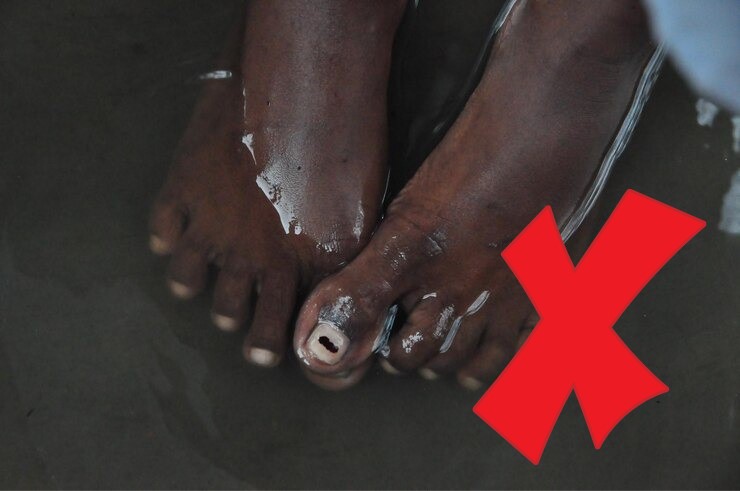
Avoid soaking your feet in water
Cultivate the habit of washing your feet with warm water and mild or neutral soap every day. After washing, dry them well, especially the spaces between your toes, where fungi love to grow. Avoid soaking your feet, as it can remove the natural oils that protect your skin and leave you more prone to cracks and infections.
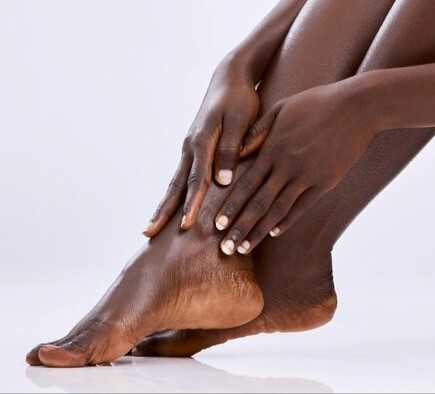
Close up of the feet of an African lady being moisturised
After washing and drying your feet, apply a good moisturiser to keep the skin soft and prevent cracks. Shea butter and petroleum jelly work well. The heels and soles of the feet get dry easily, so focus on those areas. Do not apply moisturiser between your toes, as retained moisture can promote athlete’s foot.
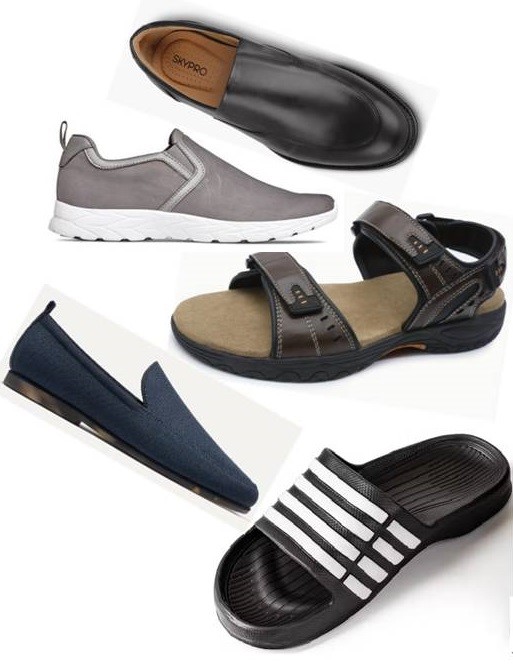
A collection of comfortable shoes for diabetics
The kind of shoes you wear can determine how likely you are to get injured. Shoes that are too tight can cause blisters, corns, or bunions, while loose shoes may lead to friction and foot ulcers. Always wear well-fitting, closed-toe shoes with soft soles and enough space for your toes. Avoid wearing high heels, worn-out shoes, or slippers that do not properly support your feet.
5. Cut Your Toenails Carefully

Toenails undergoing careful trimming and filing by a manicurist
Wearing closed-toe shoes with long toenails can cause pressure, pain, or even wounds. Trim your toenails straight across using clean clippers. Don’t try to curve or dig into the sides, as this can injure the skin and lead to infections. Also, avoid using artificial nails or extensions on your toes. They can trap dirt, hide early signs of infection, and increase your risk of nail injuries.
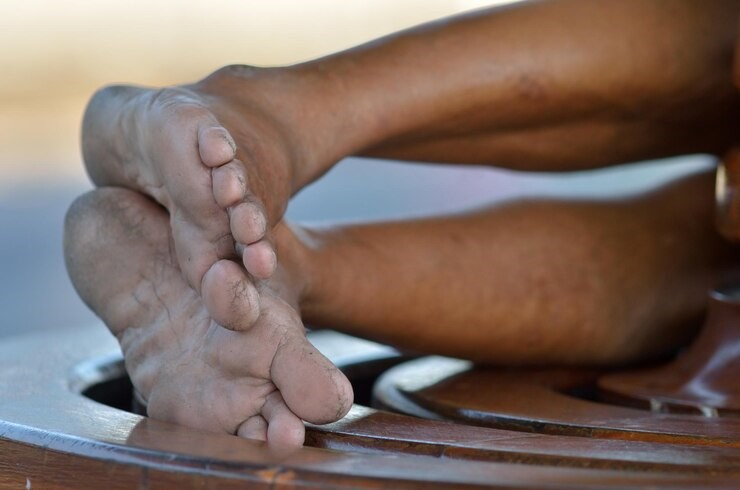
Close up of the lower legs and feet of an African lying on the right side.
People with diabetes are known for their reduced healing abilities especially when it comes to foot injuries. If you develop ingrown toenails, corns, calluses, or any wounds on your feet, do not try to treat them yourself using sharp objects, blades, or unverified home remedies. This can lead to cuts, burns, infections, and make the problem worse.
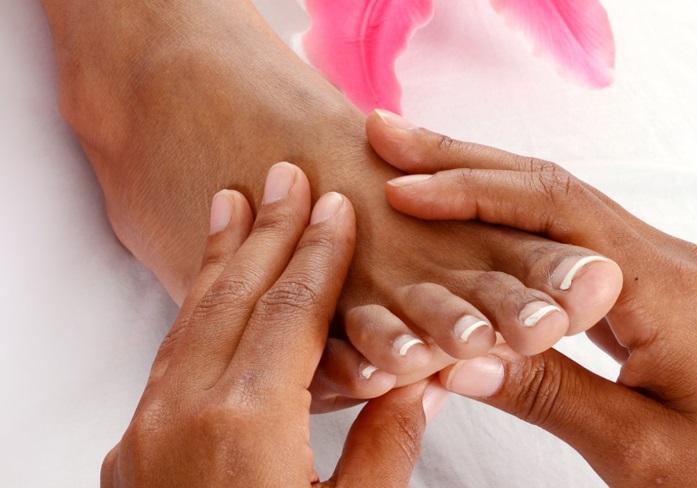
A healthcare provider checking up a foor.
If you notice any injury, swelling, or change in your feet, visit your doctor or nurse immediately. Don't stay at home and wait to see if it will heal. Early treatment can prevent serious complications like infections or amputations.
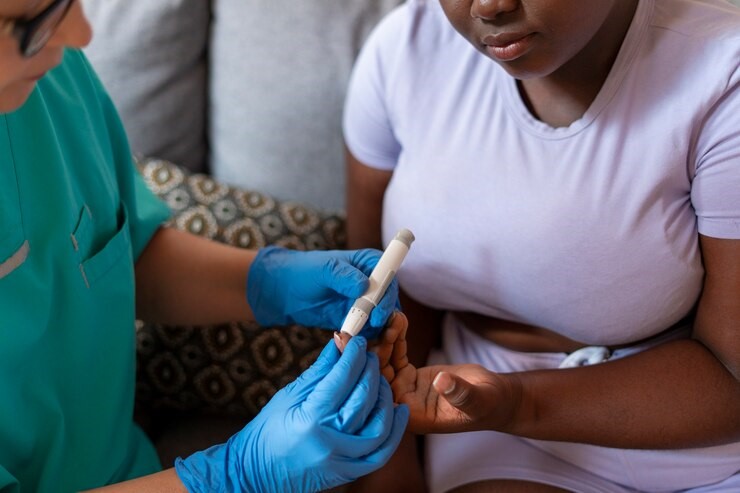
Close up of An African lady having a blood sugar check with a healthcare providder.
Even if you follow all the foot care tips above, it won’t matter much if you don’t consistently take your insulin or diabetes medications as prescribed. Good blood glucose control reduces damage to the nerves and blood vessels, giving you a better sense of touch, faster wound healing, and lower risk of foot complications.

IPhot image of a drinking glass, cigarette ash tray with cigarette stubs, a pack of cigarettes, few unsmoked cigarette sticks and caplets placed freely on a dark coloured table.
If you care for your feet, you need to avoid alcohol or smoking. Smoking reduces blood flow to the legs and feet, while excessive alcohol damages the nerves. They slow down wound healing, make it harder to feel injuries, increase your risk of infections and amputations, and also make blood sugar control more difficult.
While individual efforts like these daily foot care habits are essential, the broader outlook for diabetic foot care in Africa still faces several challenges that go beyond personal responsibility.
Cases of diabetes complications among African diabetics are rising, and so are the challenges in managing them. However, there are ongoing efforts to raise awareness and improve outcomes. Foot care education is one such effort. Initiatives like the Step-by-Step Foot Project and the Train the Foot Health Care Professional program aim to strengthen this vital preventive tool. Despite these efforts, diabetes mellitus still accounts for 36.9% (pooled prevalence) of non-traumatic leg amputations in sub-Saharan Africa.
Not every case of diabetes should end in amputation, especially in Africa, where this is a high possibility. That is why foot care remains a vital part of diabetes management. Daily attention to the feet, the right habits, and early medical help can help to prevent many foot problems. However, African diabetics face challenges such as limited access to trained professionals, poor awareness, low health literacy, high treatment costs, and delayed hospital visits. All these serve as barriers to effective foot care education and care.
Toe wiggling, ankle rolls, foot stretches, patting the feet against the floor, regular walks (if there are no open wounds) and raising the feet when sitting.
Never soak their feet in water for too long. Never cut corns, calluses or toenails carelessly. Never ignore wounds or colour changes.
Inspection, Hygiene, Moisturising, Protection and Action.
1. Armstrong DG, Fisher TK, Lepow B, et al. Pathophysiology and principles of management of the diabetic foot. In: Fitridge R, Thompson M, editors. Mechanisms of vascular disease: a reference book for vascular specialists [Internet]. Adelaide (AU): University of Adelaide Press; 2021. Chapter 26. Available from here.
2. Abbas ZG, Boulton AJM. Diabetic foot ulcer disease in African continent: ‘From clinical care to implementation’ – Review of diabetic foot in last 60 years – 1960 to 2020. Diabetes Res Clin Pract. 2022 Jan;183:109155. Available from here.
3. Mokoala TC, Sididzha V, Molefe ED, Luvhengo TE. Life expectancy of patients with diabetic foot sepsis post-lower extremity amputation at a regional hospital in a South African setting: A retrospective cohort study. Surgeon. 2024 Apr;22(2):e109–e114. Available from here.
4. Rigato M, Pizzol D, Tiago A, Putoto G, Avogaro A, Fadini GP. Characteristics, prevalence, and outcomes of diabetic foot ulcers in Africa: A systematic review and meta-analysis. Diabetes Res Clin Pract. 2018 Aug;142:63–73. Available from here.
5. Centers for Disease Control and Prevention (CDC). Your feet and diabetes [Internet]. Atlanta (GA): CDC; 2024 May 15 [cited 2025 Jun 20]. Available from here.
6. Abbas ZG, Gangji RR. The diabetic foot: progress in Sub-Saharan Africa. Diabetes Res Clin Pract. 2025 Jul;225:112264. Available from here.
7. Abbas ZG, Archibald LK. Challenges for management of the diabetic foot in Africa: doing more with less. Int Wound J. 2007 Oct 24;4(4):305–13. Available from here.
Related:
Type 1 Diabetes Mellitus: An Explainer for Africans
Type 2 Diabetes: What Africans Need to Know
You May Have Prediabetes and Not Know. How to Find Out (Tips)
Economic Impact of Diabetes in Sub-Saharan Africa
Published: August 1, 2025
© 2025. Datelinehealth Africa Inc. All rights reserved.
Permission is given to copy, use and share content freely for non-commercial purposes without alteration or modification and subject to source attribution.
DATELINEHEALTH AFRICA INC., is a digital publisher for informational and educational purposes and does not offer personal medical care and advice. If you have a medical problem needing routine or emergency attention, call your doctor or local emergency services immediately, or visit the nearest emergency room or the nearest hospital. You should consult your professional healthcare provider before starting any nutrition, diet, exercise, fitness, medical or wellness program mentioned or referenced in the DatelinehealthAfrica website. Click here for more disclaimer notice.